A Statistical Approach to Using Remote Sensing Data to Discern Streamflow Variable Influence in the Snow Melt Dominated Upper Rio Grande Basin
Abstract
:1. Introduction
1.1. Estimating Streamflow: The Response Variable
1.2. The Predictor Variables
2. Materials and Methods
2.1. Study Area
2.2. Data Description
Data Processing
2.3. AICcmodavg’ Package and Second-Order Akaike Information Criterion (AICc)
2.4. Analytical Procedure
3. Results
3.1. Predictor and Response Variable Colinearity
3.2. Predictor Variable Ranking Model
Intercept-Only Model
3.3. Model with 120 Different Orders
3.4. Interpretation
3.4.1. Interpretation by Predictor Variables
3.4.2. Interpretation by Mountain Range
3.5. Estimation of Parameters by Period
3.5.1. Interpretation by Variables and Watershed
3.5.2. Interpretation by Mountain Range and Season
3.6. Discussion
4. Conclusions
Supplementary Materials
Author Contributions
Funding
Acknowledgments
Conflicts of Interest
Appendix A. Monthly Mean Naturalized Streamflow for Each Sub Basin
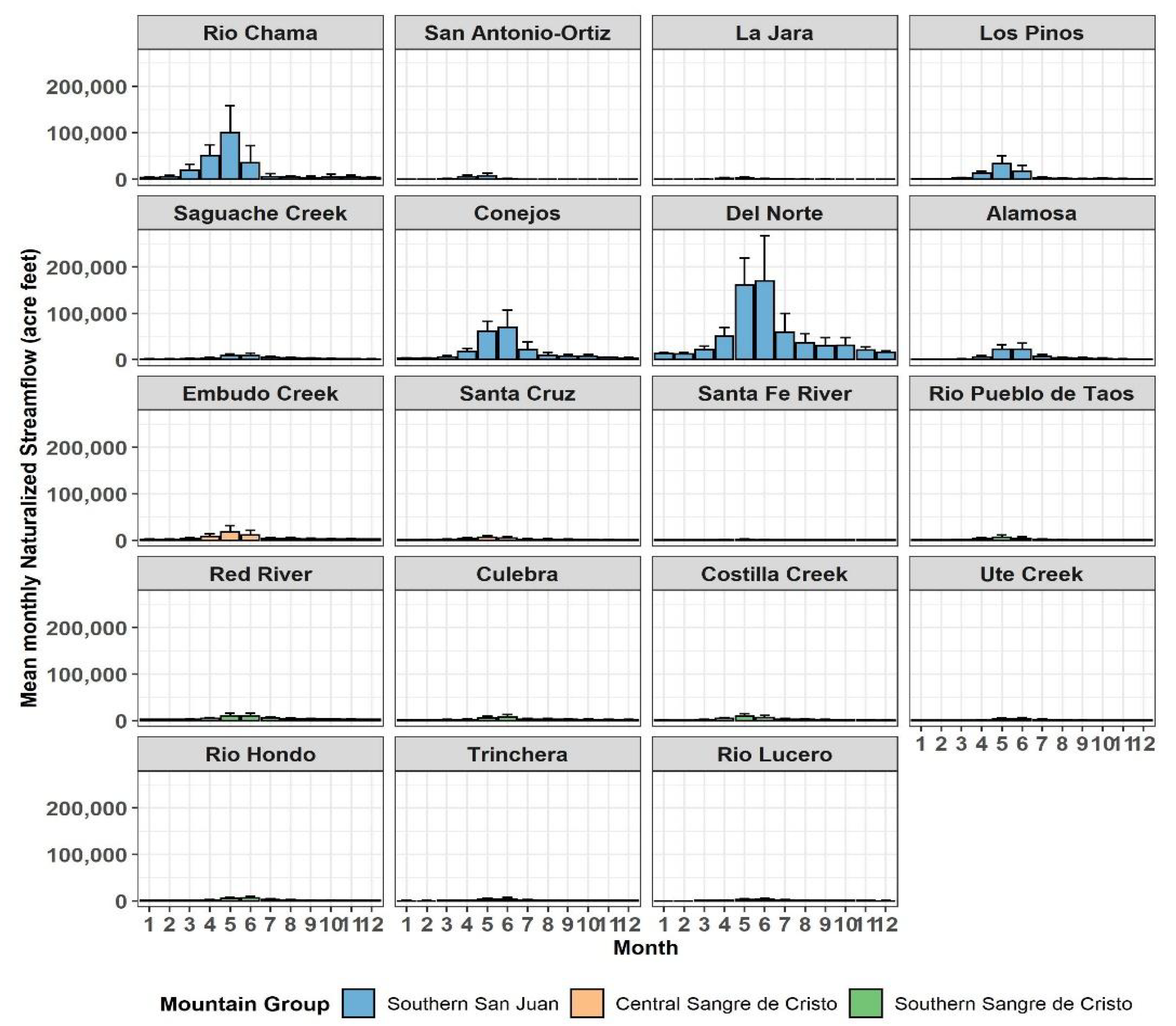
Appendix B. SWE and Sublimation in Summer Months


Appendix C. Pearson’s Correlation Coefficients with Naturalized Streamflow by Month
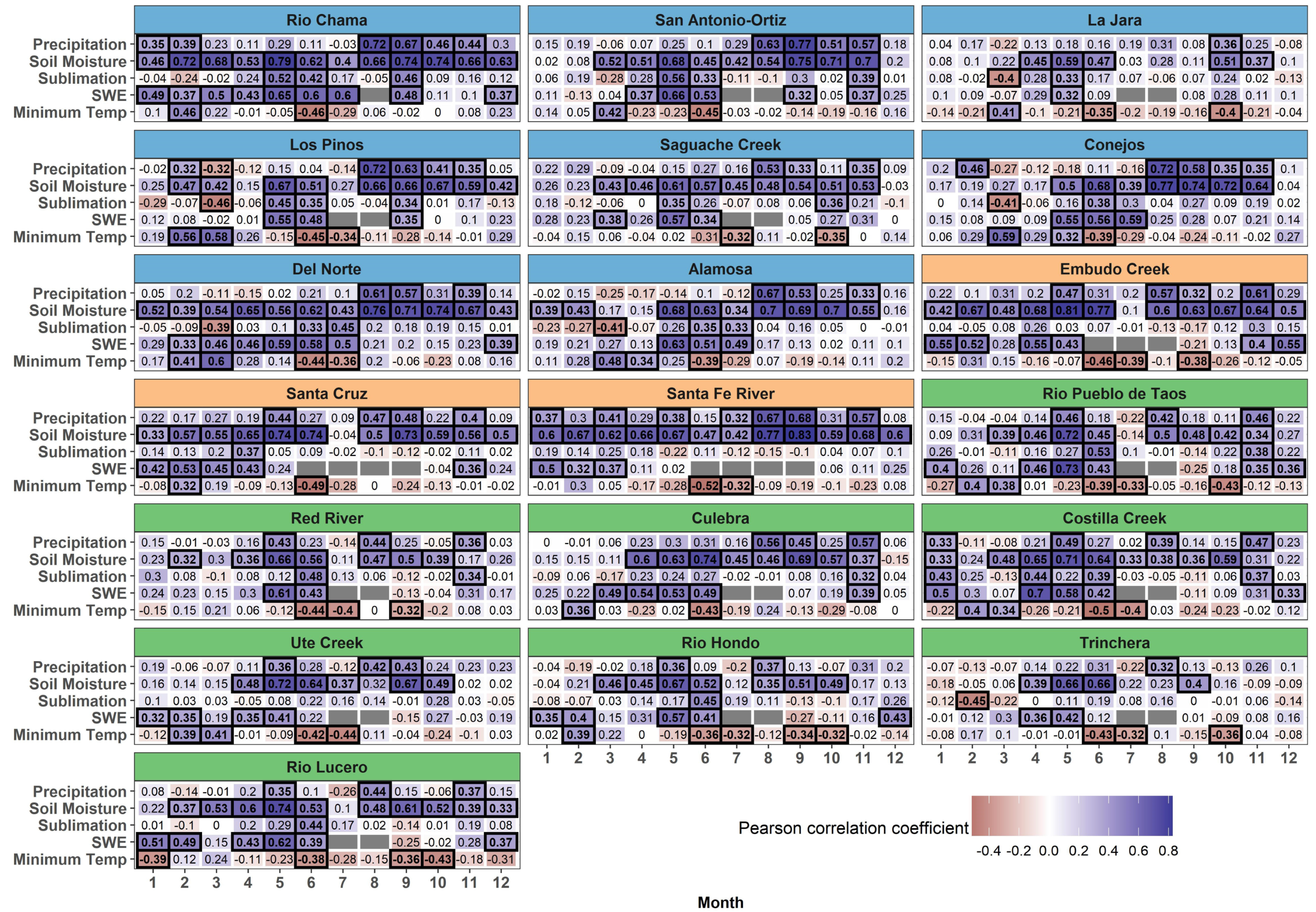
References
- Dettinger, M.; Udall, B.; Georgakakos, A. Western Water and Climate Change. Ecol. Appl. 2015, 25, 2069–2093. [Google Scholar] [CrossRef] [PubMed] [Green Version]
- Chavarria, S.B.; Gutzler, D.S. Observed Changes in Climate and Streamflow in the Upper Rio Grande Basin. JAWRA J. Am. Water Resour. Assoc. 2018, 54, 644–659. [Google Scholar] [CrossRef] [Green Version]
- Problem|WildEarth Guardians. Available online: http://www.rethinkingtherio.org/problem (accessed on 24 April 2022).
- The Vanishing Rio Grande: Warming Takes a Toll on a Legendary River. Available online: https://e360.yale.edu/features/warming-and-drought-take-a-toll-on-the-once-mighty-rio-grande (accessed on 23 September 2022).
- Garen, D.; Perkins, T.; Abramovich, R.; Julander, R.; Kaiser, R.; Lea, J.; McClure, R.; Tama, R. Snow Survey and Water Supply Forecasting; Water Supply Forecasting; Natural Resources Conservation Service, USDA: Washington, DC, USA, 2011; p. 25.
- U.S. Internation Boundary & Water Commission. Available online: https://www.ibwc.gov/crp/riogrande.htm (accessed on 21 September 2022).
- MacDonald, G.M. Water, Climate Change, and Sustainability in the Southwest. Proc. Natl. Acad. Sci. USA 2010, 107, 21256–21262. [Google Scholar] [CrossRef] [PubMed] [Green Version]
- Lehner, F.; Wahl, E.R.; Wood, A.W.; Blatchford, D.B.; Llewellyn, D. Assessing Recent Declines in Upper Rio Grande Runoff Efficiency from a Paleoclimate Perspective. Geophys. Res. Lett. 2017, 44, 4124–4133. [Google Scholar] [CrossRef]
- Fleming, S.W.; Vesselinov, V.V.; Goodbody, A.G. Augmenting Geophysical Interpretation of Data-Driven Operational Water Supply Forecast Modeling for a Western US River Using a Hybrid Machine Learning Approach. J. Hydrol. 2021, 597, 126327. [Google Scholar] [CrossRef]
- NRCS National Water and Climate Center—Publication—Water Supply Forecasts—A Field Office Guide for Interpreting Streamflow Forecasts—Section 2—Questions and Answers. Available online: https://www.wcc.nrcs.usda.gov/factpub/fcst_s2.htm (accessed on 3 April 2020).
- Zhang, Y.; Touzi, R.; Feng, W.; Hong, G.; Lantz, T.C.; Kokelj, S.V. Landscape-Scale Variations in near-Surface Soil Temperature and Active-Layer Thickness: Implications for High-Resolution Permafrost Mapping. Permafr. Periglac. Process. 2021, 32, 627–640. [Google Scholar] [CrossRef]
- Lehner, F.; Wood, A.W.; Llewellyn, D.; Blatchford, D.B.; Goodbody, A.G.; Pappenberger, F. Mitigating the Impacts of Climate Nonstationarity on Seasonal Streamflow Predictability in the U.S. Southwest. Geophys. Res. Lett. 2017, 44, 12208–12217. [Google Scholar] [CrossRef] [Green Version]
- Shultz, D. Snowpack Data Sets Put to the Test. Available online: https://doi.org/10.1029/2020EO141900 (accessed on 10 April 2020).
- Park, S.-E. Variations of Microwave Scattering Properties by Seasonal Freeze/Thaw Transition in the Permafrost Active Layer Observed by ALOS PALSAR Polarimetric Data. Remote Sens. 2015, 7, 17135–17148. [Google Scholar] [CrossRef] [Green Version]
- Touzi, R. Target Scattering Decomposition in Terms of Roll-Invariant Target Parameters. IEEE Trans. Geosci. Remote Sens. 2006, 45, 73–84. [Google Scholar] [CrossRef]
- Muhuri, A.; Manickam, S.; Bhattacharya, A. Snow Cover Mapping Using Polarization Fraction Variation with Temporal RADARSAT-2 C-Band Full-Polarimetric SAR Data over the Indian Himalayas. IEEE J. Sel. Top. Appl. Earth Obs. Remote Sens. 2018, 11, 2192–2209. [Google Scholar] [CrossRef]
- Gascoin, S.; Grizonnet, M.; Bouchet, M.; Salgues, G.; Hagolle, O. Theia Snow Collection: High-Resolution Operational Snow Cover Maps from Sentinel-2 and Landsat-8 Data. Earth Syst. Sci. Data 2019, 11, 493–514. [Google Scholar] [CrossRef] [Green Version]
- Kostadinov, T.S.; Schumer, R.; Hausner, M.; Bormann, K.J.; Gaffney, R.; McGwire, K.; Painter, T.H.; Tyler, S.; Harpold, A.A. Watershed-Scale Mapping of Fractional Snow Cover under Conifer Forest Canopy Using Lidar. Remote Sens. Environ. 2019, 222, 34–49. [Google Scholar] [CrossRef]
- US EPA Office. A Closer Look: Temperature and Drought in the Southwest. Available online: https://www.epa.gov/climate-indicators/southwest (accessed on 22 September 2022).
- Elias, E.H.; Rango, A.; Steele, C.M.; Mejia, J.F.; Smith, R. Assessing Climate Change Impacts on Water Availability of Snowmelt-Dominated Basins of the Upper Rio Grande Basin. J. Hydrol. Reg. Stud. 2015, 3, 525–546. [Google Scholar] [CrossRef]
- US EPA Office. Climate Change Indicators: Snow Cover. Available online: https://www.epa.gov/climate-indicators/climate-change-indicators-snow-cover (accessed on 22 September 2022).
- Qiao, D.; Li, Z.; Zhang, P.; Zhou, J.; Liang, S. Prediction of Snow Depth Based on Multi-Source Data and Machine Learning Algorithms. In Proceedings of the 2021 IEEE International Geoscience and Remote Sensing Symposium IGARSS, Brussels, Belgium, 11–16 July 2021; pp. 5578–5581. [Google Scholar]
- Schneider, D.; Molotch, N.P. Real-Time Estimation of Snow Water Equivalent in the U Pper C Olorado R Iver B Asin Using MODIS-Based SWE Reconstructions and SNOTEL Data. Water Resour. Res. 2016, 52, 7892–7910. [Google Scholar] [CrossRef]
- Meyal, A.Y.; Versteeg, R.; Alper, E.; Johnson, D.; Rodzianko, A.; Franklin, M.; Wainwright, H. Automated Cloud Based Long Short-Term Memory Neural Network Based SWE Prediction. Front. Water 2020, 2, 574917. [Google Scholar] [CrossRef]
- Sexstone, G.A.; Driscoll, J.M.; Hay, L.E.; Hammond, J.C.; Barnhart, T.B. Runoff Sensitivity to Snow Depletion Curve Representation within a Continental Scale Hydrologic Model. Hydrol. Process. 2020, 34, 2365–2380. [Google Scholar] [CrossRef]
- Landry, C.; Buck, K. Dust-on-Snow Effects on Colorado Hydrographs. In Proceedings of the Western Snow Conference 2014, Durango, Colorado, 14–17 April 2014; p. 6. [Google Scholar]
- Goldstein, H.L.; Reynolds, R.L.; Landry, C.; Derry, J.E.; Kokaly, R.F.; Breit, G.N. The Effects of Dust on Colorado Mountain Snow Cover Albedo and Compositional Links to Dust-Source Areas. AGU Fall Meet. Abstr. 2016, 2016, A21E-0106. [Google Scholar]
- Lapp, S.; Byrne, J.; Townshend, I.; Kienzle, S. Climate Warming Impacts on Snowpack Accumulation in an Alpine Watershed. Int. J. Climatol. 2005, 25, 521–536. [Google Scholar] [CrossRef]
- Painter, T.H.; Skiles, S.M.; Deems, J.S.; Bryant, A.C.; Landry, C.C. Dust Radiative Forcing in Snow of the Upper Colorado River Basin: 1. A 6 Year Record of Energy Balance, Radiation, and Dust Concentrations. Water Resour. Res. 2012, 48, W07521. [Google Scholar] [CrossRef] [Green Version]
- Milly, P.C.D.; Dunne, K.A. Colorado River Flow Dwindles as Warming-Driven Loss of Reflective Snow Energizes Evaporation. Science 2020, 367, 1252–1255. [Google Scholar] [CrossRef]
- Cooley, E.; Frame, D.; Wunderlin, A. Soil Moisture and Potential for Runoff. 2010, p. 6. Available online: https://uwdiscoveryfarms.org/UWDiscoveryFarms/media/sitecontent/PublicationFiles/farmpagel/Soil-Moisture-and-Potential-for-Runoff-factsheet.pdf?ext=.pdf (accessed on 28 October 2020).
- USA Detailed Streams. Available online: https://www.arcgis.com/home/item.html?id=1e29e33360c8441bbb018663273a046e (accessed on 30 January 2021).
- ArcGIS 10 (Desktop, Engine, Server) Service Pack 5—English. Available online: https://support.esri.com/en/download/1876 (accessed on 2 July 2022).
- Gesch, D.B.; Evans, G.A.; Oimoen, M.J.; Arundel, S. The National Elevation Dataset; American Society for Photogrammetry and Remote Sensing: Baton Rouge, LA, USA, 2018; pp. 83–110. [Google Scholar]
- USGS Current Water Data for the Nation. Available online: https://waterdata.usgs.gov/nwis/rt (accessed on 24 April 2022).
- Loeser, C.; Rui, H.; Teng, W.; Vollmer, B.; Mocko, D. Enabling NLDAS-2 Anomaly Analysis Using Giovanni. In Proceedings of the AGU 2017 Fall Meeting H21F-1558, New Orleans, LA, USA, 11–15 December 2017. [Google Scholar]
- MODIS/Terra Snow Cover Monthly L3 Global 0.05Deg CMG, Version 6|National Snow and Ice Data Center. Available online: https://nsidc.org/data/mod10cm/versions/6 (accessed on 3 August 2022).
- PRISM Climate Group, Oregon State U. Available online: http://www.prism.oregonstate.edu/historical/ (accessed on 5 June 2020).
- DATA ACCESS-SMERGE Version 2.0. Available online: https://www.tamiu.edu/cees/smerge/data.shtml (accessed on 5 June 2020).
- GES DISC Dataset: NLDAS Mosaic Land Surface Model L4 Monthly 0.125 × 0.125 Degree V002 (NLDAS_MOS0125_M 002). Available online: https://disc.gsfc.nasa.gov/datasets/NLDAS_MOS0125_M_002/summary (accessed on 23 September 2022).
- NRCS National Water and Climate Center|Home. Available online: https://www.wcc.nrcs.usda.gov/about/forecasting.html (accessed on 3 April 2020).
- NLDAS Mosaic Land Surface Model L4 Monthly 0.125 × 0.125 Degree V002 (NLDAS_MOS0125_M) at GES DISC. Available online: https://cmr.earthdata.nasa.gov/search/concepts/C1233767610-GES_DISC.html (accessed on 23 September 2022).
- Data Catalogues. Available online: https://jornada.nmsu.edu/data-catalogs (accessed on 15 June 2020).
- RStudio|Open Source & Professional Software for Data Science Teams—RStudio. Available online: https://www.rstudio.com/ (accessed on 22 September 2022).
- Goodbody, A. Stream Flow Data 2020. Unpunlished work.
- Water Supply Forecasts—A Field Office Guide for Interpreting Streamflow Forecasts—Section 1—Narrative. Available online: https://www.wcc.nrcs.usda.gov/factpub/fcst_s1.htm (accessed on 3 April 2020).
- Mazerolle, M.J. AICcmodavg. R Package; Version 2.3-1; The R Foundation: Vienna, Austria, 2020; Available online: https://cran.r-project.org/web/packages/AICcmodavg/AICcmodavg.pdf (accessed on 11 November 2021).
- Mazerolle, M.J. Model Selection and Multimodel Inference Using the AICcmodavg Package 2020. Available online: https://cran.r-project.org/web/packages/AICcmodavg/vignettes/AICcmodavg.pdf (accessed on 11 November 2021).
- Burnham, K.P.; Anderson, D.R.; Burnham, K.P. Model Selection and Multimodel Inference: A Practical Information-Theoretic Approach, 2nd ed.; Springer: New York, NY, USA, 2002; ISBN 978-0-387-95364-9. [Google Scholar]
- Anderson, D.; Burnham, K. Model Selection and Multi-Model Inference, 2nd ed.; Springer: New York, NY, USA, 2004; Volume 63, p. 10. [Google Scholar]
- Cade, B.S. Model Averaging and Muddled Multimodel Inferences. Ecology 2015, 96, 2370–2382. [Google Scholar] [CrossRef] [PubMed] [Green Version]
- Al-Samman, E.N. The Influence of Transparency on the Leaders’ Behaviors. Master’s Thesis, Open University Malaysia (OUM), Petaling Jaya, Malaysia, 2012. [Google Scholar]
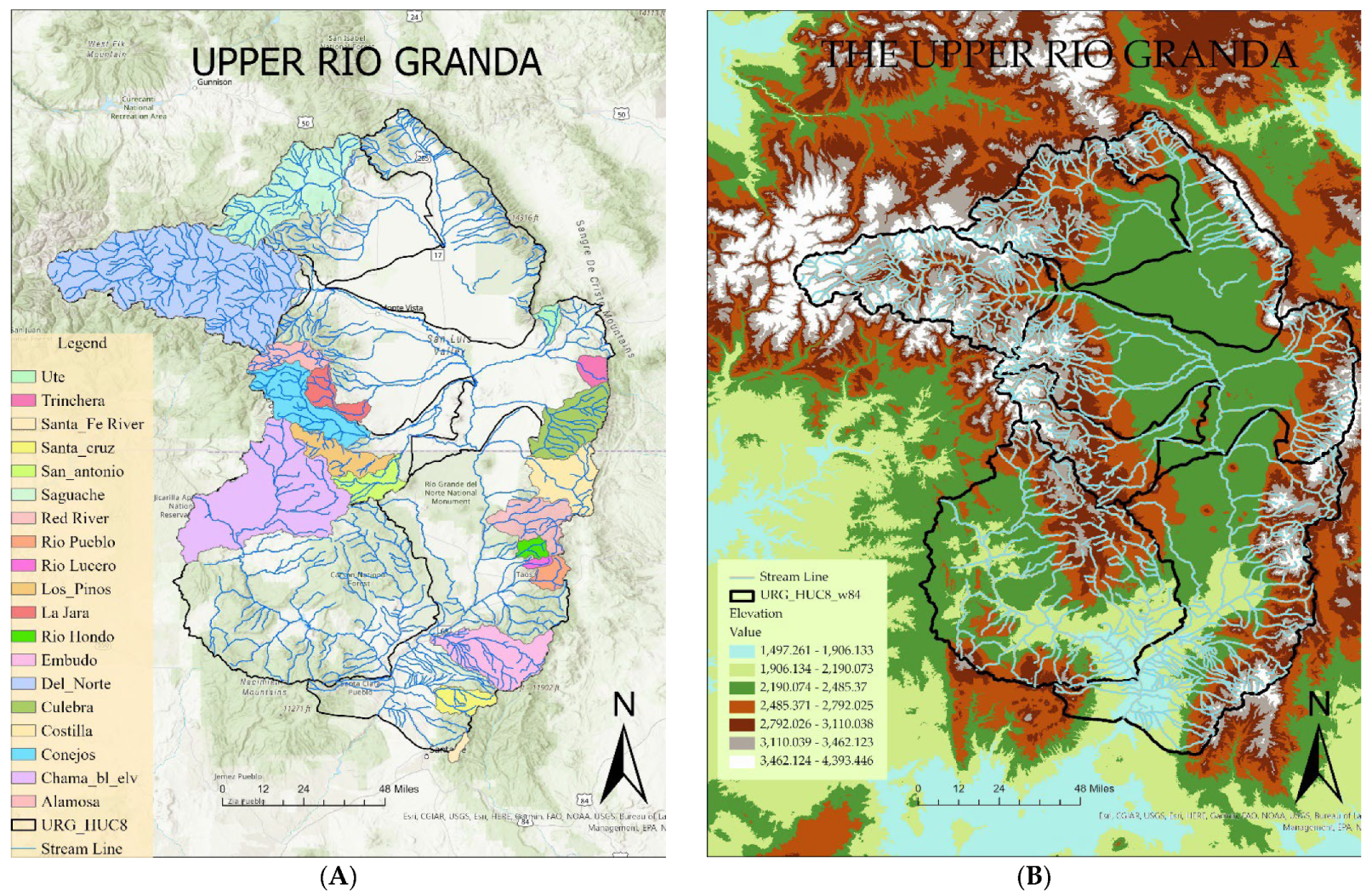
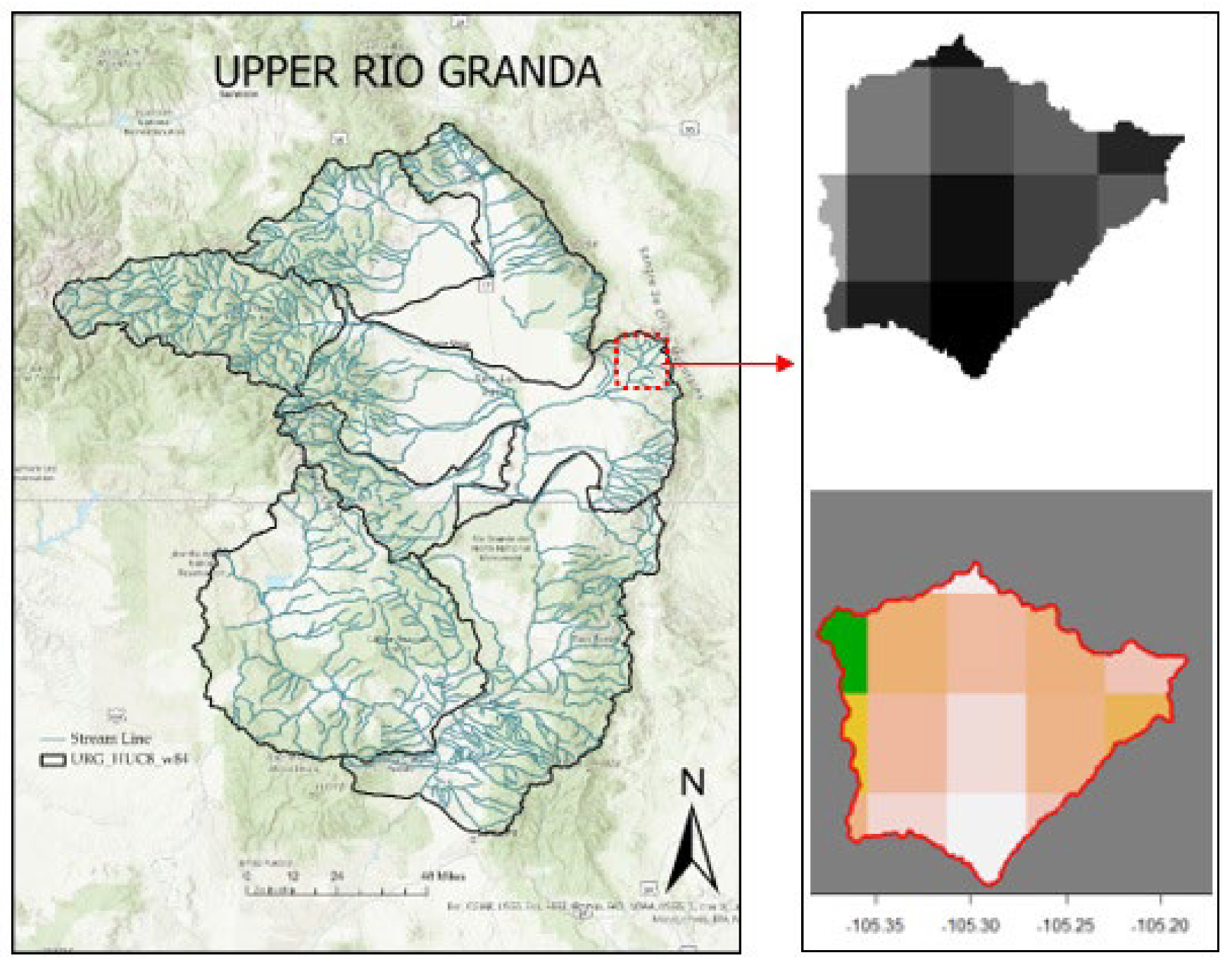
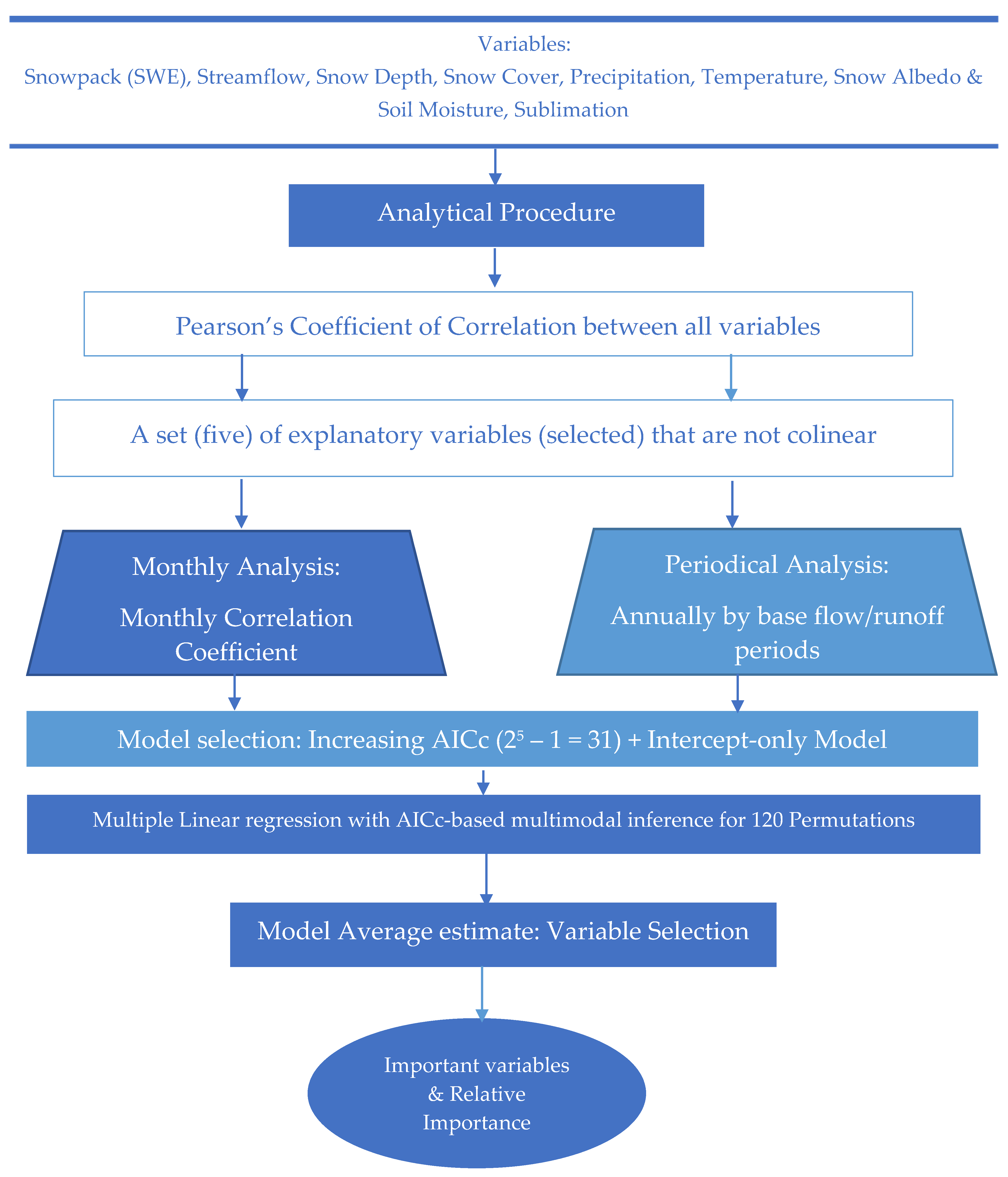
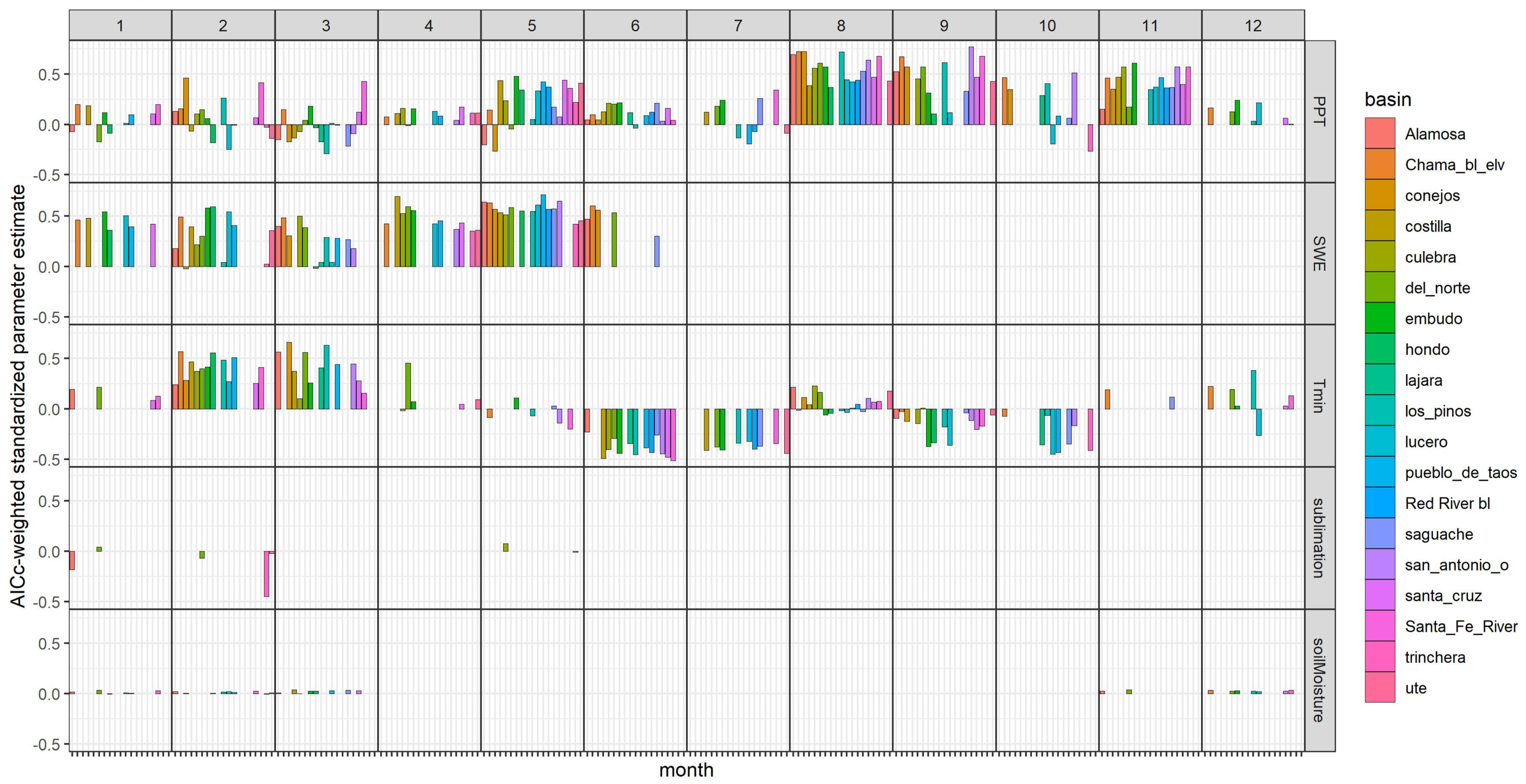

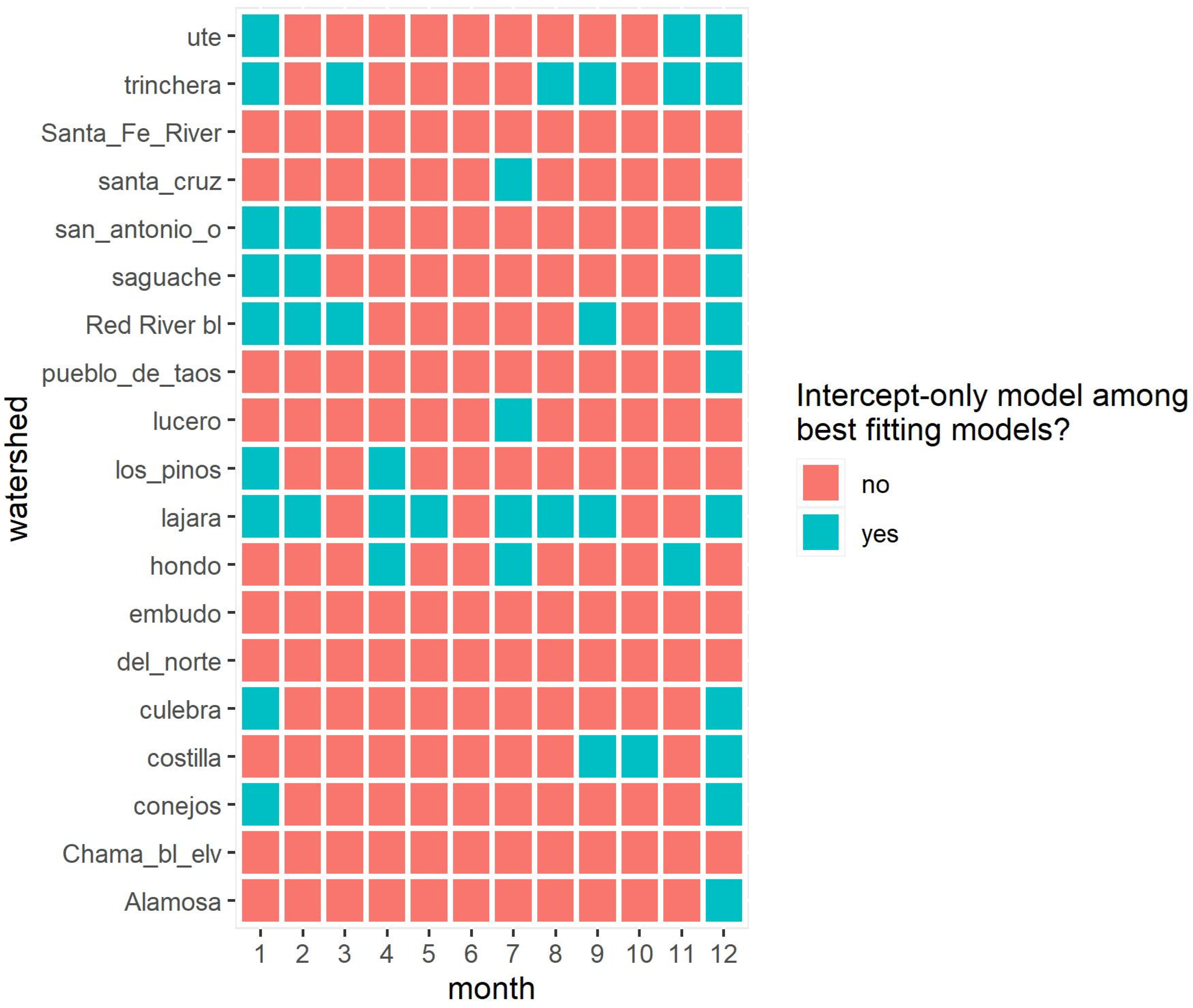

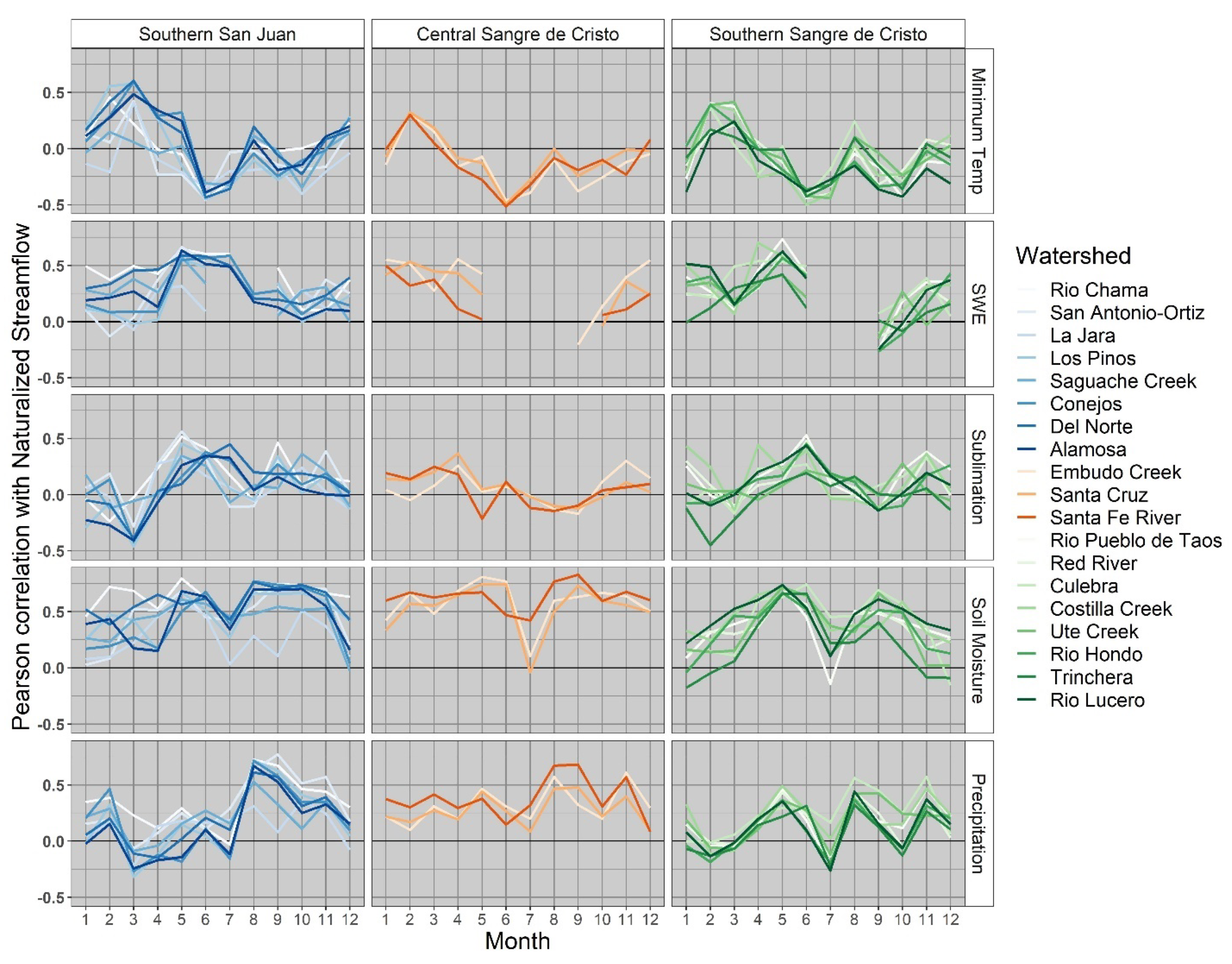

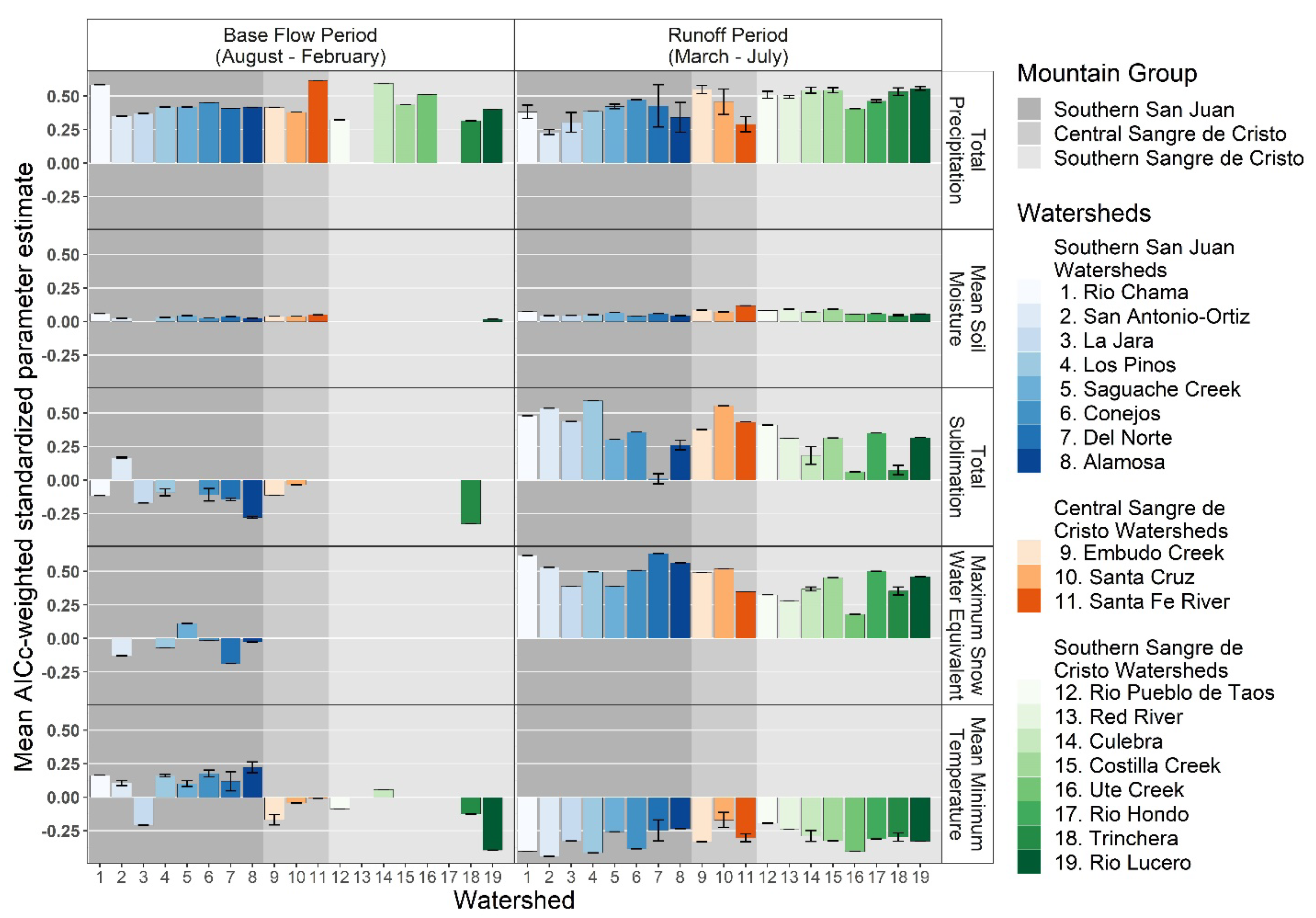
| USGS Gauging Station | Basin Area (sq-km) | Elevation Range (m.a.s.l) | |
|---|---|---|---|
| Alamosa | 08236000 | 274 | 2624–4036 |
| Conejos | 08246500 | 729 | 2524–4005 |
| Costilla Creek | 08255500 | 566 | 2409–3941 |
| Culebra | 08250000 | 649 | 2428–4265 |
| Del Norte | 08220000 | 3396 | 2436–4222 |
| Embudo Creek | 08279000 | 828 | 1787–3912 |
| La Jara | 08238000 | 266 | 2464–3632 |
| Los Pinos | 08248000 | 395 | 2454–3716 |
| Red River below Fish Hatchery near Questa | 08266820 | 290 | 2276–3988 |
| Rio Chama below el Vado dam | 08285500 | 1222 | 2159–3886 |
| Rio Hondo | 08267500 | 96 | 2349–3992 |
| Rio Lucero | 08271000 | 43 | 2472–3976 |
| Rio Pueblo de Taos | 08269000 | 150 | 2262–3892 |
| Saguache Creek | 08227000 | 1340 | 2448–4229 |
| San Antonio-Ortiz | 08247500 | 298 | 2437–3327 |
| Santa Cruz | 08291000 | 239 | 1974–3972 |
| Santa Fe River | 08316000 | 47 | 2368–3757 |
| Trinchera | 08240500 | 137 | 2601–4113 |
| Ute Creek | 08242500 | 104 | 2459–4351 |
| Variables | Type of Data | Unit | Source/Organization |
|---|---|---|---|
| Snow-water Equivalent (SWE) | Raster: monthly mean | Kg/m2 | Goddard Earth Sciences Data and Information Services Center, or GES DISC—National Aeronautics and Space Administration (NASA) [36] |
| Snow cover | Raster: monthly mean | Fraction | Moderate Resolution Imaging Spectroradiometer (MODIS)—National Aeronautics and Space Administration (NASA) [37] |
| Temperature | Raster: monthly mean and minimum | Celsius (°C) | Parameter-elevation Regression on Independent Slopes Model (PRISM) [38] |
| Precipitation | Raster: monthly mean | mm | Parameter-elevation Regression on Independent Slopes Model (PRISM) [38] |
| Sublimation | Raster: monthly | Watt/m2 | Goddard Earth Sciences Data and Information Services Center, or GES DISC—National Aeronautics and Space Administration (NASA) [39,40] |
| Naturalized Streamflow | Hydrograph Monthly Volume | Ac-ft | Natural Resources Conservation Service (NRCS) [41] |
| Soil Moisture | Raster: monthly | Kg/m2 | Center for Earth and Environmental Studies, Texas A & M International University [39] |
| Snow Depth | Raster: monthly | Meter (m) | Goddard Earth Sciences Data and Information Services Center, or GES DISC—National Aeronautics and Space Administration (NASA) [39,40] |
| Snow Albedo | Raster Monthly | % | Goddard Earth Sciences Data and Information Services Center, or GES DISC—National Aeronautics and Space Administration (NASA) [39,42] |
| Stream Layer | Feature | N/A | ESRI—Environmental Systems Research Institute [32] |
| Basin Boundary | Feature | N/A | USDA Southwest Climate Hub, Jornada Experimental Range (JER) [43] |
| Variable | Aggregation Method |
|---|---|
| Naturalized Streamflow | Summation of each month of the season |
| Snow Water Equivalent (SWE) | Monthly Maximum for the season |
| Soil Moisture | Seasonal average |
| Precipitation | Summation of each month of the season |
| Sublimation | Summation of each month of the season |
| Minimum Temperature | Seasonal average |
| Important Variables | ||||||||
|---|---|---|---|---|---|---|---|---|
| Rank of the Parameters: Baseflow Period | Rank of the Parameters: Runoff Period | |||||||
| Rank1 | Rank2 | Rank3 | Rank4 | Rank1 | Rank2 | Rank3 | Rank 4 | |
| Rio Chama | Total Precipitation | Mean Min. Temp. | Total Sublimation | Maximum SWE | Total Sublimation | Mean Min. Temp. | Total Precipitation | |
| San Antonio | Total Precipitation | Total Sublimation | Maximum SWE | Mean Min. Temp. | Total Sublimation | Maximum SWE | Mean Min. Temp. | Total Precipitation |
| La Jara | Total Precipitation | Mean Min. Temp. | Total Sublimation | Total Sublimation | Maximum SWE | Mean Min. Temp. | Total Precipitation | |
| Los Pinos | Total Precipitation | Mean Min. Temp. | Max. SWE | Total Sublimation | Maximum SWE | Mean Min. Temp. | Total Precipitation | |
| Saguache Creek | Total Precipitation | Max. SWE | Mean Min. Temp. | Total Precipitation | Maximum SWE | Total Sublimation | Mean Min. Temp. | |
| Conejos | Total Precipitation | Mean Min. Temp. | Total Sublimation | Maximum SWE | Total Precipitation | Mean Min. Temp. | Total Sublimation | |
| Del Norte | Total Precipitation | Max. SWE | Total Sublimation | Mean Min. Temp. | Maximum SWE | Total Precipitation | Mean Min. Temp. | |
| Alamosa | Total Precipitation | Total Sublimation | Mean Min. Temp. | Maximum SWE | Total Precipitation | Total Sublimation | Mean Min. Temp. | |
| Embudo Creek | Total Precipitation | Mean Min. Temp. | Total Sublimation | Total Precipitation | Maximum SWE | Total Sublimation | Mean Min. Temp. | |
| Santa Cruz | Total Precipitation | Total Sublimation | Maximum SWE | Total Precipitation | Mean Min. Temp. | |||
| Santa Fe River | Total Precipitation | Total Sublimation | Maximum SWE | Total Precipitation | Mean Min. Temp. | |||
| Rio Pueblo de_taos | No variable | Total Precipitation | Total Sublimation | Maximum SWE | Mean Min. Temp. | |||
| Red River | Total Precipitation | Total Precipitation | Total Sublimation | Maximum SWE | Mean Min. Temp. | |||
| Culebra | Total Precipitation | Total Precipitation | Maximum SWE | Mean Min. Temp. | Total Sublimation | |||
| Costilla Creek | Total Precipitation | Total Precipitation | Maximum SWE | Mean Min. Temp. | Total Sublimation | |||
| Ute Creek | Total Precipitation | Total Precipitation | Maximum SWE | Mean Min. Temp. | Total Sublimation | |||
| Rio Hondo | Total Precipitation | Maximum SWE | Total Precipitation | Total Sublimation | Mean Min. Temp. | |||
| Trinchera | Total Precipitation | Maximum SWE | Total Sublimation | Total Precipitation | Mean Min. Temp. | |||
| Total Precipitation | Maximum SWE | Total Sublimation | Total Precipitation | Mean Min. Temp. | ||||
Publisher’s Note: MDPI stays neutral with regard to jurisdictional claims in published maps and institutional affiliations. |
© 2022 by the authors. Licensee MDPI, Basel, Switzerland. This article is an open access article distributed under the terms and conditions of the Creative Commons Attribution (CC BY) license (https://creativecommons.org/licenses/by/4.0/).
Share and Cite
Islam, K.I.; Elias, E.; Brown, C.; James, D.; Heimel, S. A Statistical Approach to Using Remote Sensing Data to Discern Streamflow Variable Influence in the Snow Melt Dominated Upper Rio Grande Basin. Remote Sens. 2022, 14, 6076. https://doi.org/10.3390/rs14236076
Islam KI, Elias E, Brown C, James D, Heimel S. A Statistical Approach to Using Remote Sensing Data to Discern Streamflow Variable Influence in the Snow Melt Dominated Upper Rio Grande Basin. Remote Sensing. 2022; 14(23):6076. https://doi.org/10.3390/rs14236076
Chicago/Turabian StyleIslam, Khandaker Iftekharul, Emile Elias, Christopher Brown, Darren James, and Sierra Heimel. 2022. "A Statistical Approach to Using Remote Sensing Data to Discern Streamflow Variable Influence in the Snow Melt Dominated Upper Rio Grande Basin" Remote Sensing 14, no. 23: 6076. https://doi.org/10.3390/rs14236076






